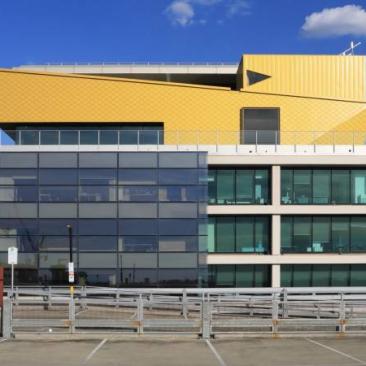CLT, what is it?
Developed in the 1970s in Switzerland, Cross Laminated Timber (CLT) is made by bonding solid-sawn timber together in transverse and longitudinal layers with structural adhesives to produce timber panels.
Depending on the natural characteristics of the timber species, the cross-lamination process provides strength and stiffness properties similar to a ferroconcrete slab and panels can be used to construct floors, walls and roofs.
Constructing a CLT building can be quicker, cleaner, quieter and less disruptive when compared to more traditional construction methods.
CLT forms part of a product suite associated with Mass Timber Construction, which is part of prefabricated construction.
The Building Research Establishment in the UK has certified the CLT product for a life span of 60 years. In Europe you can find timber buildings that are over 700 years old and still have people living in them.
XLam provides a range of services from design, to manufacturing and installation. The timber used in the process comes from sustainably managed forests in Australia or New Zealand.
This high tech timber got a humble start in Nelson, New Zealand.
In 2010, the Jack brothers pioneered their expert knowledge of engineered wood products to become the first ever Cross Laminated Timber (CLT) manufacturer in the Southern Hemisphere. Their first factory in Nelson, NZ became a success story.
In 2016, the Nelson site gained FSC certification and XLam expanded across the Tasman, opening a second factory in Wodonga, Australia. The Wodonga factory aims to join its NZ counterpart and become certified sometime in 2019.

Last year we wrote about biophilia and the mental and emotional benefits of using wood in construction.
Building with wood is thought to improve air quality and humidity, leading to easier breathing, lower blood pressure, lower stress levels and feelings of warmth and comfort.
As we gain a better understanding of the carbon emissions produced by the construction industry, new material and processes highlight the stellar environmental performance of timber-based systems in construction.
Cement-making alone produces 6% of the world’s carbon emissions and steel accounts for another 8%.
Building with timber from FSC certified forests helps to reduce carbon emissions, while also producing economic benefits like faster building time. Timber can also gain extra charm and character when recycled.
Through recycling timber can continue to keep carbon out of the atmosphere even at the end of its first life cycle.
1. Removing carbon from the atmosphere
Trees absorb carbon from the atmosphere and store in the wood. So planting trees helps soak up even more carbon from the atmosphere.
When plantation trees, used in products such as CLT are harvested sustainably according to FSC principles, the carbon is trapped in the timber for its lifetime.
As CLT in Australia and New Zealand is made primarily from Pinus Radiata, these plantations are re-planted with the new trees soaking-up more carbon.
2. Taller buildings, built faster
At 20% of the density and weight of products like concrete timber is an incredibly light, yet durable, building material. Builders and architects can use timber to create building that tower over those built with concrete.
In Melbourne, a ten storey vertical extension is currently under construction. CLT was chosen as the heavier concrete alternative could only be used for a six storey construction, due to weight factors.
Prefabricated methods of construction using CLT, for example, have a faster assembly time when compared to more traditional methods. Indeed, reports indicate a 30% faster construction time.
The Canadian project, Brock Commons Tallwood House was completed four months faster using timber compared to conventional methods, at an astonishing rate of two floors a week.
3. Timber building materials gaining a second life
The recyclability of timber is another major asset to the building with CLT. It's possible to re-purpose wooden structures into beautiful furniture and interiors, or even tiny homes.
Reclaimed timber has great warmth and character. Giving it new life in new projects is really ‘making the old, new again’.
